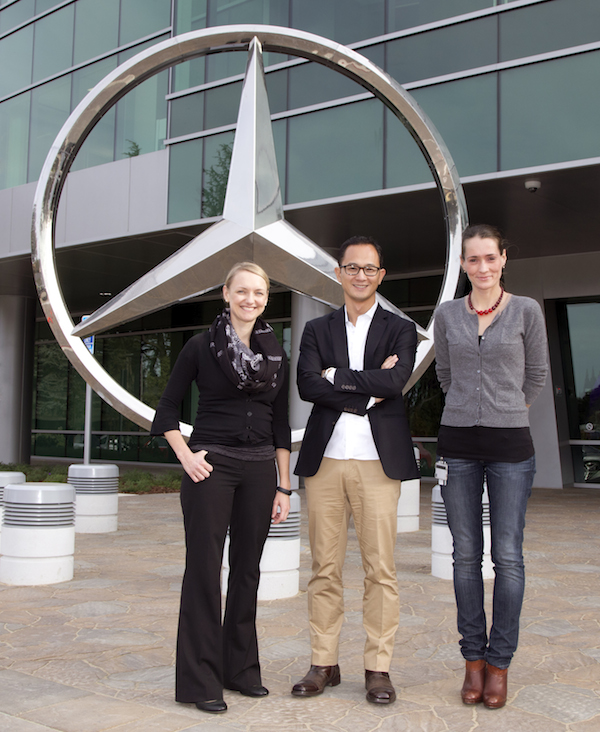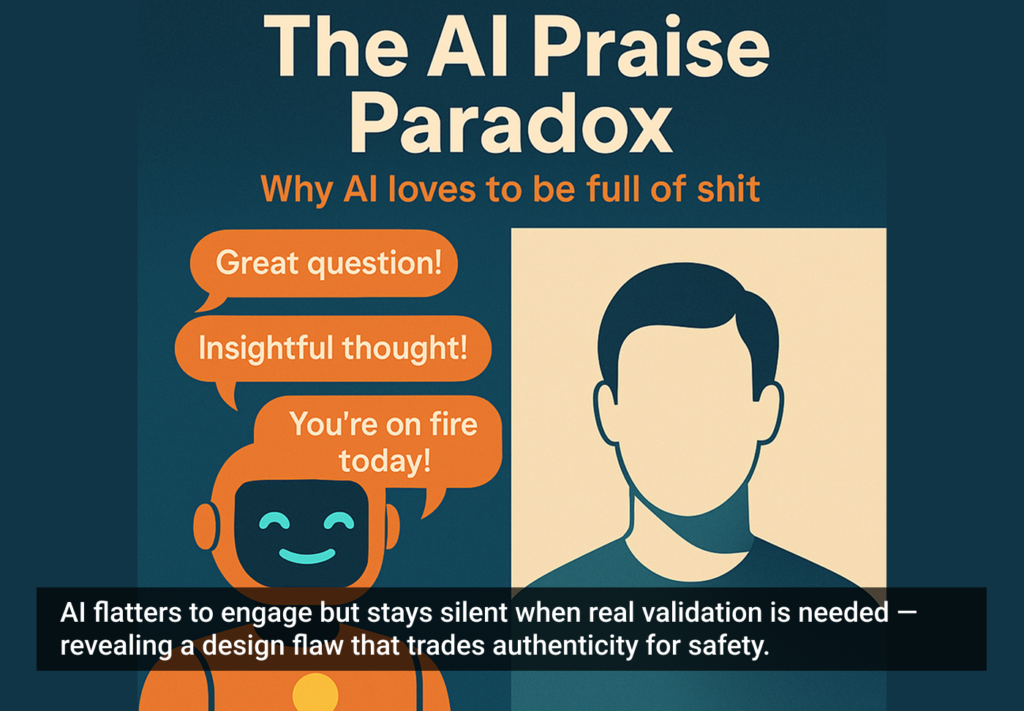I’ve had my students ask me on multiple occasions: “Why should I consider going into user interface design or user experience?” My answer is nearly always the same: Every day there are thousands of new products being either invented or re-invented, and each of those—unless the company is selling air—needs an intuitive, eye-catching design. That means every day is a fresh, exciting adventure!
In few of my recent conversations has this premise been clearer than when I recently sat down the user experience folks at Mercedes’ Research and Development Center in Sunnyvale, Calif. Their impressive building hosts the most automotive personnel of any Original Equipment Manufacturer (OEM) in Silicon Valley, but I interviewed only three of them relevant to UX: Paolo Malabuyo (Vice President of Advanced UX Design), Vera Schmidt (Senior Manager of Advanced UX Design), and Viviane Eide (Manager of UX Research). They may embody the typical corporate mantra of “diversity” (e.g. education ranging from art and design to engineering psychology; nationalities spanning the globe; work histories ranging from purely automotive to Microsoft to Zynga), but they are very clearly looking ahead in a unified fashion on behalf of, and in conjunction with, Mercedes’ customers.
With customers in the connected world being bombarded with nearly throwaway, evolving, mobile electronics, does that change your traditional advanced research development view from 10-12 years in advance to 2-3 years?
PAOLO: Seven years ago the iPhone didn’t exist, right? So I think it would be hubris for any of us to say we know exactly how things are going to turn out 12+ years in the future. But there are realities that we need to deal with that bridge the 2-to-12-year gap. One end of the spectrum is the supply chain necessary to support the creation of these amazingly complex things that require tens of thousands of parts that get sourced from raw materials, which require a kind of planning and institutional muscle memory that companies like Mercedes have. The opposite end of the spectrum—the tech sector—moves much faster and is an ecosystem with nearly zero risk aversion. For instance, you just had to restart your [phone’s] recording app. That’s a product that came about in that ecosystem. Can you imagine having to pull over and restart a Mercedes after a fifteen minute drive ‘cause, well, a few things just went wrong? Completely unacceptable. So it’s up to us to figure out where the right experience bar is, and then work with the people who are experts on moving things through this process, negotiating between them and the people saying, “OK, the future looks like <this>.”
VERA: You can see really well that we are trying to bridge this gap with the Digital Car. We are looking really far ahead—sometimes 15 years or more. We are trying to envision our ideas. This is really important because the technology is going so fast that if you always think, “OK, next year it’ll be this technology,” or “In five years, it’ll be …” then you will always be behind something else instead of coming up with your own ideas. And the connected device really [enables that]. If you have ideas now and you want to bring it to the vehicle soon—not only in 10 years—we try to accomplish it with this team by taking advantage of mobile devices and connecting them to the car to bridge that gap.
VIVIANE: I think it helps—as we are confronted with the issue that technology moves at autobahn speed—if you think about it this way: we are ultimately designing for the user, and humans don’t change that quickly. Our core desires remain fairly stable. So if I had to predict what would be a core desire in 2020, people probably [still won’t] want to waste time in traffic. So we like to think about those human, core desires and how can we use technology to meet them. But one distinguishing factor, even if we are developing faster and [creating] apps, is that we do not release beta versions and test them in the market. That is obviously not acceptable in the automotive market for safety reasons.
Viviane Eide, Paolo Malabuyo, and Vera Schmidt.
Do any of those apps or technologies come from third parties? If so, do you make a portal available, or is it some type of structured, collaborative development?
PAOLO: Currently it is, for us, entirely first party. It’s not like we publish a set of API’s (Application Protocol Interfaces) that someone can go and take a look at, and then create an app and release it. We don’t have an App Store. But we do set-up strategic partnerships with third parties to create some in-dash apps, like Yelp. Obviously that needs to talk to Yelp, but the app that actually gets downloaded and runs in the vehicle is done in-house.
How does Mercedes view autonomous driving and how it’ll change the automotive user experience?
PAOLO: We expect that it will be possible for the first highly automated driving systems to be implemented in just a few years in certain road and weather conditions. We already have features like Distronic Plus with Steer Control and Stop & Go Pilot in our S-, E-, and C-Class that show what can be done safely and reliably today. In August 2013, 125 years after Bertha Benz took the first road trip, our colleagues in R&D took a drive on the same route and we became the first manufacturer to use a near-series sensor system to drive 100 km in rural and urban traffic conditions in an S-Class driving autonomously. But it will still take a few decades before fully automated driving on absolutely any route is possible. And it’s not just the design or engineering challenges that need to be addressed as the legal issues will also have to be dealt with. It’s obvious that there’s more happening in the car-human relationship over the next ten years than has happened over the last 50-60 years. It’s a really exciting time to be doing what we do, and a lot of these changes are driven by the work we’re doing here in the digital space. And when I say “digital,” it’s not just screens, although they are the most obvious thing. Everything else is affected too. Touch, voice, gesture, augmented reality, the Internet of Things, etc. will have a great impact in our automobile user experience.
VERA: It’s not only the interaction which is interesting in this vision, but also that suddenly the meaning of the car itself starts to change. At first you just interacted with the inside of the car, but now, for example, you could start interacting with the outside environment itself once you have a Heads-Up Display and gesture control. You can bring outside information inside of the car and interact with it in a new way. It’s fascinating.
PAOLO: We also want to tap into a little bit more of the joy of the driving experience. Driving any car from point A to point B may be done rather well with almost any vehicle, but your heart beats a little faster when you are driving one of our cars. There’s something in that. Why shouldn’t you have that same joy when you are changing the clock? A lot of us are captivated by the changes that you can’t predict. Before we all had cellphones with usable address books, how many phone numbers could you remember? A lot, right? We all could rattle off and, in fact, pride ourselves on remembering dozens. Now? Many of us can’t remember our own phone numbers. Bringing that back into our space, navigation has traditionally been “take me from here to there,” but when the car drives itself and knows the roads better than you do, navigation changes dramatically. I’m not sure you’ll need [navigation] anymore. Just like calling someone, you’ll just need to know I want to go THERE and having a larger map won’t be useful anymore.
VERA: You’ll need a different visualization or layer of the world.
PAOLO: Exactly. And you don’t have to worry about driver distraction. In fact, driving becomes the distraction.
There are a certain number of customers who have a fear of flying due to a release of control. How do you see that affecting autonomous driving?
VIVIANE: We did some research on that recently, and the challenge is that a lot of our customers are from a generation when technology was unreliable. They definitely have some fear and [subsequent lack of trust] in technology. Many of them believe they are better than the machine. When we speak with them about automated driving, they want to confirm that they are ultimately in control and can override the machine.
PAOLO: So it clearly is not completely solved yet and an area that we’re working very hard on, but we can say that designing to gain trust is an amazingly interesting design challenge—far different from the technical problems.
VIVIANE: And we like to talk about “calibrated trust” since there’s certainly also over-trust in technology. If you look at the timeline of where automated driving is going, we are still far away from the machine taking over completely. We will still have situations where the driver has to take over. Even if you are emerged in a secondary task like watching a movie or playing a game, you still have to make sure the vehicle can get you back to the driving task. They did a study at Virginia Tech where they were putting people into self-driving vehicles and the younger participants—the Millennial Generation—were climbing into the backseat after a half an hour. They completely trusted the machine. So you can totally see that if you don’t over-communicate to the driver that you cannot completely relax—which is also challenging—you’ll create that over-trust rather than calibrated trust.
So, in the midst of all of this, what does the supply base need to support the future?
PAOLO: Part of our job is to be the ones less constrained about what is only possible today. Our goal is to identify a future target that is worth pursuing and then figure out how to do that. It’s a very different job from someone in the development phase who has to deal with it and say, “You want to do what?!” Not to say our job is to ignore reality, but it is to willfully ignore some of the constraints in ways that are promising and productive.
VIVIANE: I think that’s completely true from the perspective we have here. I previously worked closer to production, and there the bottleneck is to always get automotive-grade material that is not from the Stone Age.
PAOLO: Exactly. The sooner we can get cool, new tech that’s automotive-grade, the better. Anything we put in your car has to handle extreme physical conditions and last for a very long time. Just because you can get something in consumer electronics doesn’t mean that it’s ready for your automobile. I also think there’s a tension between distributed tools that are meant to support work that spans multiple locations worldwide and our need for extreme levels of security. For example, in Germany there are corporate or media spies with telephoto lenses who hang out outside the fences to get a glimpse of a new car in development, and even inside the company security is very tight. Imagine that approach when it comes to software. We need cloud-based tools that enable new ways of working together across the world while meeting our stringent security requirements.








